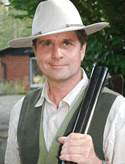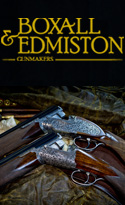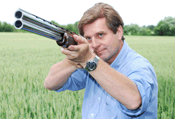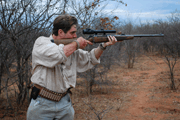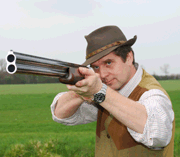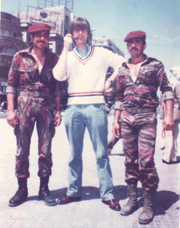Dealing With Recoil
Are you affected by recoil? Many shooting men and women are. There is no need to suffer. Let’s consider what might be done about it. First, a bit of physics. As you may remember from school days, to every action there is an equal and opposite reaction (Newton’s Third Law). Recoil is the motion of a gun in the opposite direction to its projectile. Various factors need to be considered when thinking about the physics of recoil: muzzle velocity, gun weight, projectile weight.
There are two phases of recoil, moreover. Primary recoil begins momentarily after the firing pin hits the primer. Propellant rapidly creates an expansion of gas that overcomes the inertia of the bullet or shot charge and wad and accelerate them down the barrel against the force of friction and air resistance. Secondary recoil – the effects of which are much smaller – starts when the ejecta (pellets, wad and burnt powder) leave the barrel and there is a sudden release of gas. The gun is pushed back much like a rocket.
Recoil is not only about rearwards movement, though. There is also a rotation about the axis of the shoulder. This is because the centre line of the bore/s is above the shoulder line. When this rotation effect occurs, the muzzle/s moves up and the comb of the gun may be brought into abrupt contact with the cheekbone. At the same time the butt sole may slip from the shoulder (especially if it is poorly designed). A gun with a steeply angled cheek piece will be especially uncomfortable.
It’s not just about primary and secondary recoil. We must distinguish felt or perceived recoil - the experience of recoil by the gun user – from observed recoil. Felt recoil is a complex subjective phenomenon involving many variables. Factors affecting felt recoil will include those already mentioned (weight of the gun, projectile weight etc.), the design and fit of the gun stock, the burn rate of the powder, the physique, strength and constitution of the individual, the firing position (firing from a prone position may increase felt recoil because movement is severely restricted - one cannot 'roll with the punches') and, not least, the individual's shooting technique and experience. A gun held loosely or in insufficient contact with the shoulder - a common failing of beginners - will appear to recoil far more than one held more firmly. [Experienced shots, however, do become expert at absorbing recoil through the hands]
Having noted primary and secondary recoil and felt recoil, we might move on to distinguish between the subjective experience of recoil and the actual effects of it. They are not necessarily synonymous. For example, a situation could be conceived where an individual was being damaged by recoil without being aware of it at the time of firing. Excessive recoil in firearms has certainly been recognised as a problem for hundreds of years. Moreover, different users may react quite differently to the same gun and cartridge combination. Some people are clearly more sensitive to recoil than others. Poor technique or unsuitable equipment are usually to blame for recoil problems, but, not always.
There has been a progressive reduction in the maximum permitted loads in International and domestic clay pigeon shooting competition in recent years because of concerns about recoil. The first reduction was made by UIT (the International Shooting Union - the body which controls Olympic clay pigeon shooting) in 1976. Others followed in 1989 and 1993. Similar initiatives have been made by domestic clay pigeon shooting associations. I use 24 gram loads by choice now for nearly all my shotgun shooting. I have also moved over to softer recoiling rifle rounds (for example I have moved from 300 Win Mag to 300 WSM)
Excessive recoil can lead to flinching - a sudden muscle tension or spasm in anticipation of recoil - and to neck and shoulder problems (especially in those who shoot a great deal). Any professional shooting instructor will have heard clients complaining of recoil on hundreds of occasions: a significant part of my instructional work involves altering firearms or technique to reduce recoil in one way or another.
Cartridge makers are especially conscious of the potential problem of recoil (and the market demand for low recoiling cartridges) and have developed cartridges which allow for high velocities but relatively low felt recoil. This is achieved by various means which include, careful propellant and primer selection and development, the introduction of shock absorbing base wads, compressing plastic wads, and, not least, by the fashion for reduced cartridge payload.
Gun designers are well aware of the problem of recoil too. There has been much experimentation to reduce the actual and felt recoil of firearms in recent years. The trend in the military has been towards much smaller cartridges for rifles. The .303 and .308 have now been replaced with the much softer shooting, 5.56mm. Shotgun manufacturers have experimented with bore size and bore geometry as a means of reducing felt recoil. The softest shooting shotguns in my experience are gas operated semi-automatics. I am also a believer in wider than average bore dimensions – tightly bored gun and tightly choked guns seem to recoil more.
Many products have been marketed over the years as a means to reduce felt recoil. These include recoil pads, muzzle brakes, barrel porting, mercury and mechanical 'recoil' reducers, lengthened forcing cones (the funnel like constriction which leads from the bore of a shotgun to the main bore), the back boring of barrel (widening the bore size), pneumatic, sprung or hydraulic telescopic stock conversions, and padded cheek pieces. Some of these devices have a negligible effect (mercury recoil reducers), some are well proven (e.g. recoil pads made of modern shock absorbing materials).
The commonest causes of excessive felt recoil are poor mounting technique, poor stock design and/or fit and unsuitable cartridge-gun combinations as noted. The simplest cures are light loaded, light payload, cartridges and the fitting of one of the modern high-tech polymer pads such as the Kick-Eez. If you shoot clays or pigeons consider a gas-operated semi-automatic if all else fails.
It is only common sense to keep recoil to a minimum. With a suitable gun, we are all capable of firing thousands of shots a year without discomfort or harm (my annual average is about 20,000). Do not ignore recoil though. If you do suffer there is a reason. Check that your technique is sound. Make sure that your gun fit is o.k. (not to short a stock, not too high or low in the comb, and not too angled). Make sure that the gun and cartridge combination are suitable. If you are firing 1 oz. loads in a 6lb 20 bore it will kick.


